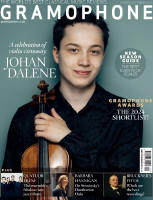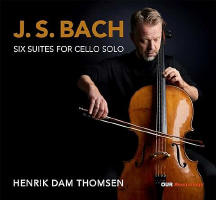Texte paru dans: / Appeared in:
|
|
|
|
|
|
There’s arguably no such thing as a non-impactful opening to a Bach Solo Cello Suites recording. That said, the presence of these readings from Danish National Symphony Orchestra solo cellist Henrik Dam Thomsen is significant. It helps that this former pupil of William Pleeth and János Starker has stuck to his own modern-set-up 1680 Ruggieri – a magnificent instrument – strung with his usual modern strings, tuned to modern 442Hz, and played with his usual conventional bow; in simple terms of power and volume he inevitably occupies a different plane from anyone going authentically Baroque with any or all of their tools.
Another major – really major – contributing factor is the tremendous warmth and bloom, and upper-register precision, afforded by Copenhagen’s Garnisons Kirke with its unusual combination of huge, galleried, twolevel, cathedral-size Baroque interior and a wooden floor. But there’s also Thomsen’s playing, because the overwhelming impression is of a cellist playing as comes naturally, with his very personal, timeless (albeit period-aware) response to the music: long-lined, melodious expressivity; gentle vibrato and portamento touches; and delicate, constantly varying embellishments which he won’t keep for the repeat if the mood takes him early (so he’s right in there in bar 5 of Suite No 1’s Prelude, tucking in a softly crystalline addition). Also, of a cellist alive to this music’s dance and folk elements, and the possibilities of bringing its own conversation into further conversation with this bigpersonality church acoustic. Thomsen recently turned 50, and 40 of those years have been spent playing the Suites. In the recording notes, he describes how the pandemic lockdowns of 2020-22 prompted newly intensive exploration of the set, then performing them as a whole, and in turn gaining a clearer picture of their sequence and steady accumulation in gravity, length and experimentalism. Certainly he brings out this progression, from the quiet purity of his Suite No 1 to the dark profundity of the Fifth – and oh my, how this church acoustic serves the deep, black, organ rumble of his bottom C at the outset of the Fifth’s Prelude. The Sixth Prelude then sees him draw special magic from the acoustic, first with his pronounced forte/piano echo effects (the score’s only dynamic markings), and later his stroking of its high tenor-clef notes to produce a meltingly beautiful, sweetly amber chime (listen onwards from 3'00"). Inevitably, the bloom spins a gorgeous halo too around slow movements, such as his expressive, slow-spun Second Suite Sarabande.
Everywhere there is the sense of dance: that same Suite’s pair of Menuets are thoroughly danceable with their crisp beat and gently detached articulation; and I love the way the second’s trills flutter with seductive cut-glass definition. The Fourth’s Sarabande progresses with a steady-pulsed, nobly gliding lilt, this pulse and the sharp spring of its dotted figures gradually driving its gathering emotional weight.
For a colouristic twist, try after the double bar, first time around, in Suite No 5’s Gigue, where he drops its bar 55 trill, then trills that of the following bar using such a narrow interval that the weirdly fabulous effect is of a nasal wiggle. Or for something very beautiful, listen to the thoroughly Arcadian hurdy-gurdy in Suite No 6’s second Gavotte with its smoothly lilting rise and fall.
It’s a tough field of competition for this repertoire, but this is distinctive and exceptionally finely done. |
|




